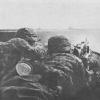Where is the Black Sea Fleet located? Black Sea Fleet of the Russian Navy. I am a marine brigade of the Russian Black Sea Fleet
Operational-strategic formation of the Russian Navy on the Black Sea. Subordinate to the southern military district. Crossed out text indicates ships/boats undergoing repairs.
30th division of surface ships (Sevastopol)
"Moskva" guards missile cruiser of project 1164. Board number 121.
“Admiral of the Fleet of the Soviet Union Gorshkov” frigate of project 22350. Board number 417 (put into service in 2016).
“Admiral of the Fleet Kasatonov” frigate of project 22350 (put into service in 2017).
"Admiral Grigorovich" is a patrol ship of Project 11356. Board number 494.
"Admiral Essen" is a patrol ship of Project 11356. Board number 751.
“Admiral Makarov” is a patrol ship of Project 11356. Board number 799 (put into service in 2016).
"Smart" patrol ship of project 01090. Board number 810.
"Ladny" patrol ship of project 1135. Board number 861.
“Inquisitive” patrol ship of Project 1135M. Board number 868.
RK-1078 - raid boat.
RK-1210 - raid boat.
RK-1287 - raid boat.
RK-1414 - raid boat.
RK-1676 - raid boat.
RBK-1299 - raid longboat.
Crimean naval base (Sevastopol)
197th Brigade of Landing Ships (Crimean Naval Base, Sevastopol):
"Nikolai Filchenkov" large landing ship of Project 1171. Board number 152.
BDK-65 "Saratov" large landing ship of Project 1171. Board number 150.
BDK-69 "Orsk" large landing ship of Project 1171. Board number 148.
BDK-46 "Novocherkassk" large landing ship of Project 775. Board number 142.
BDK-54 "Azov" guards large landing ship of Project 775M. Airborne number 151.
BDK-64 "Caesar Kunikov" large landing ship of Project 775. Board number 158.
BDK-67 "Yamal" large landing ship of Project 775. Board number 156.
68th brigade of water area security ships (Sevastopol):
149th tactical group:
MPK-49 “Aleksandrovets” is a small anti-submarine ship of Project 1124. Board number 059.
MPK-118 “Suzdalets” is a small anti-submarine ship of Project 1124M. Board number 071.
MPK-134 "Muromets" is a small anti-submarine ship of Project 1124M. Board number 064.
150th tactical group:
"Ivan Golubets" sea minesweeper of project 266M. Tail number 911.
"Vice Admiral Zhukov" sea minesweeper of Project 266M. Board number 909.
"Turbinist" sea minesweeper of project 266M. Board number 912.
"Kovrovets" sea minesweeper of project 266M. Board number 913.
41st Missile Boat Brigade (Sevastopol):
166th MRK battalion (Sevastopol):
"Bora" rocket hovercraft of project 1239. Board number 615.
"Samum" hovercraft missile ship of project 1239. Board number 616.
"Mirage" is a small rocket ship of project 12341. Board number 617.
"Shtil" is a small rocket ship of project 12341. Board number 620.
“Vyshny Volochyok” is a small missile ship of Project 21631 (put into service in 2017).
295th Sulina missile boat division:
R-60 “Burya” missile boat of project 12411. Hull number 955.
R-71 "Shuya" missile boat of project 12417. Hull number 962.
R-109 "Breeze" missile boat of project 12411. Hull number 952.
R-239 "Groza" missile boat of project 12411. Hull number 953.
R-334 “Ivanovets” missile boat of project 12411M. Board number 954.
102nd special forces detachment for combating PDSS, military unit 27203 (Sevastopol): 60 people. In service: coastal self-propelled bomb-throwing systems DP-62 "Damba", anti-sabotage boats P-424, P-331, P-355, P-407, P-424, P-834, P-835, P-845.
Novorossiysk naval base (Krasnodar region, Novorossiysk)
184th Water District Protection Brigade (Krasnodar Territory, Novorossiysk):
181st division of anti-submarine ships:
MPK "Povorino" is a small anti-submarine ship of Project 1124M. Board number 053.
MPK "Yesk" is a small anti-submarine ship of Project 1124M. Board number 054.
MPK "Kasimov" is a small anti-submarine ship of Project 1124M. Board number 055.
170th minesweeper division:
MTSH "Zheleznyakov" sea minesweeper of project 12660. Board number 901.
MTSH "Valentin Pikul" sea minesweeper of project 266ME. Board number 770.
MTSH "Vice Admiral Zakharyin" is a sea minesweeper of project 02668. Board number 908.
BTSH "Mineralnye Vody" is a basic minesweeper of project 12650. Board number 426.
BTSH "Lieutenant Ilyin" basic minesweeper of project 12650. Board number 438.
RT-46 raid minesweeper of project 1258. Board number 201.
RT-278 is a Project 12592 road minesweeper.
D 144 - landing boat.
D 106 - landing boat.
D-199 - landing boat.
4th separate submarine brigade (Krasnodar region, Novorossiysk):
B-237 "Rostov-on-Don" diesel submarine of project 06363.
B-261 "Novorossiysk" diesel submarine of project 06363.
B-262 "Stary Oskol" diesel submarine of project 06363.
B-265 "Krasnodar" diesel submarine of project 06363.
B-268 "Veliky Novgorod" diesel submarine of project 06363.
B-271 "Kolpino" diesel submarine of project 06363 (put into service in 2016).
B-871 "Alrosa" diesel submarine of Project 877B.
PZS-50 is a Project 633RV diesel submarine.
UTS-247 is a diesel submarine of Project B613.
TL-997 is a Project 368T torpedo boat.
TL-1539 - torpedo boat of Project 1288.
VM-122 diving sea vessel.
314th detachment of rescue vessels (Novorossiysk):
PZhK 58 - fire boat.
VM 86 is a Project 522 diving vessel.
VM 108 is a Project 522 diving vessel.
VM 159 is a Project 535 diving vessel.
SB 4 - sea tug of project 733.
VM 66 is a Project 522 diving vessel.
Orion is a Project 733 sea tug.
RVK-764 raid boat of project 23040.
RVK-762 raid boat of project 23040.
RVK-767 raid boat of project 23040.
RVK-771 raid boat of project 23040.
“Professor Nikolay Muru” is a rescue tugboat of project 22870.
136th special forces detachment for combating PDSS, military unit 75976 (Novorossiysk): 60 people. In service: anti-sabotage boats P-191, P-349, P-350, P-274, P-275, P-276, P-356.
separate security company, military unit 70118 (Krasnodar region, Novorossiysk, Myskhako village).
63rd brigade of repaired ships (Sevastopol).
145th Emergency Rescue Squad (Sevastopol):
"EPRON" rescue ship of project 527M.
RVK-1112 is a raid boat for comprehensive emergency rescue support.
SMK-2094 is a multifunctional rescue boat.
1st group of rescue ships (Sevastopol):
"Commune" rescue ship.
"Shakhtar" rescue tug of project 712.
SB-5 sea tug project 733.
SB-36 sea tug of project 714.
MB 304 sea tug of project 745.
2nd group of rescue ships (Sevastopol):
CH 126 ambulance boat.
VM 154 is a Project 535 diving vessel.
RVK 449 diving boat of project 376.
RVK 860 diving boat of project 376.
PZhK 37 - fire boat.
PZhK 45 - fire boat.
VM 125 is a Project 522 diving vessel.
PZhS-123 fire ship project 1893.
VM 9 is a Project 522 diving vessel.
519th separate division of reconnaissance ships (Sevastopol):
"Priazovye" medium reconnaissance ship of Project 864.
"Equator" is a small reconnaissance ship of Project 861M.
"Kildin" small reconnaissance ship of Project 861M.
"Liman" is a small reconnaissance ship of Project 861M.
97th separate division of surface ships (Krasnodar region, Temryuk):
SKhZ-18 is a storage vessel of project 08142.
RK-249 is a Project 376 diving boat.
Seliger is an experimental vessel of Project 11982.
RB 45 is a Project 90600 road tug.
176th division of hydrographic vessels (Sevastopol):
"Donuzlav" hydrographic vessel of project 862.
"Cheleken" hydrographic vessel of project 861.
"Stor" hydrographic vessel of project 862.
MGK 476 small hydrographic boat of project 16830.
BGK-2150 is a large hydrographic boat.
47th hydrographic region (Sevastopol):
GS-86 is a small hydrographic vessel of Project 872.
BGK-22 is a large hydrographic boat.
BGK-889 is a large hydrographic boat of the 1896 project.
MGK-352 small hydrographic boat of project 1403.
MGK-675 is a small hydrographic boat of Project 727M.
MGK-1002 small hydrographic boat of project 1403.
MGK-1099 small hydrographic boat of project 1403.
80th Hydrographic Service District (Krasnodar Territory, Novorossiysk):
BGK 244 is a large hydrographic boat of the 1896 project.
55th separate division of hydrographic vessels of the 80th district of the hydrographic service (Novorossiysk):
GS-103 is a small hydrographic vessel of Project 870.
GS-402 is a small hydrographic vessel of project 872.
MGK-500 small hydrographic boat of project 1403.
MGK-614 small hydrographic boat of project 16830.
MGK-1792 small hydrographic boat of project 16830.
MGK-1914 small hydrographic boat.
17th hydrograph section (Rostov region, Taganrog)
115th Commandant's Office of Security and Maintenance (Sevastopol):
RK 1529 is a Project 1415 raid boat.
CH 726 - ambulance boat.
KSV-1404 - communications boat.
KSV-1754 - communications boat.
205th detachment of support vessels (Sevastopol):
KSV-2155 - communication boat of project 1388N
1st group (Sevastopol):
MB 23 is a Project 773 sea tug.
MB 173 - sea tug of project 773
MB 174 is a Project 733 sea tug.
PM 56 is a floating workshop of project 304.
PM 138 is a floating workshop of project 304.
RB 50 is a Project 737L road tug.
RB 136 is a Project 192 road tug.
PK-3100 is a floating crane of project 605-PK.
PK-32050 is a marine self-propelled floating crane of Project 1505.
PK-128035 - floating crane V-02.
SPK-46150 is a self-propelled floating crane of project 02690.
RB 244 is a Project 737K road tug.
RB 247 is a Project 737K road tug.
RB 296 is a Project 737M road tug.
Yenisei is a hospital ship of Project 320.
RB 389 is a Project 90600 road tug.
RB-365 is a Project 90600 road tug.
2nd group (Sevastopol):
KIL-158 is a keel-lift vessel of Project 141.
Ivan Bubnov is a large sea tanker of Project 1599B.
General Ryabikov - Project 323B sea weapons transport.
VTR 94 - sea transport of weapons of Project 1823.
Setun is a cable ship of Project 1112.
Petr Gradov is an environmental control vessel of Project 872E.
SR 939 is a Project 130 degaussing vessel.
SR 26 - degaussing vessel of project 17994.
SR 137 is a degaussing vessel of Project 130.
SFP 183 is a physical field monitoring vessel of Project 18061.
Iman is a medium sea tanker of Project 6404.
SR 541 - degaussing vessel of Project 130.
3rd group (Sevastopol):
Don is a small sea tanker of Project 1852.
Indiga is a small sea tanker of Project 437N.
MUS-589 is an oil and waste recovery vessel of Project 1515.
Istra is a small sea tanker.
BNS-16500 is the base tanker of Project 445R.
MUS-229 is an oil and waste recovery vessel of Project 14630.
MUS-586 is an oil and waste recovery vessel of project 25505.
BNN-226800 is a roadstead non-self-propelled tank barge.
VTN 99 is a small sea tanker of Project 1844.
VTN-73 is a small sea tanker of project 03180.
4th group (Sevastopol):
BUK-49 is a tug boat of Project 05T.
BUK-533 is a tug boat of Project 05T.
PSK-537 is a Project 722 passenger boat.
RK-340 is a Project 1415 raid boat.
RK-1573 - raid boat.
RK 25 - raid boat.
"Afalina" is a Project 16609 raid boat.
“Dvinitsa-50” is a military transport (ex-Turkish bulk carrier Alican Deval).
"Vologda-50" - military transport (ex-Turkish bulk carrier Dadali).
"Kyzyl-60" - military transport (ex-Turkish bulk carrier Smyrna).
"Kazan-60" - military transport.
58th group of support vessels (Feodosia):
KIL-25 is a keel-lift vessel of Project 419.
MB 31 is a Project 745 sea tug.
SR 344 - degaussing vessel of project 17992.
VM 911 is a diving sea vessel of Project 535.
RB 44 is a Project 737L road tug.
RB 237 is a Project 737K road tug.
BGK 774 is a large hydrographic boat of the 1896 project.
SR 59 is a Project 130 degaussing vessel.
MUS-491 is an oil and waste recovery vessel of Project 1515.
OS-114 is an experimental vessel of Project 1824.
OS-138 is an experimental vessel of Project 1236.
MGK 620 is a small hydrographic boat of Project 16380.
RK-253 is a Project 376 diving boat.
RK-267 is a Project 376 diving boat.
RK-1677 is a Project 371U raid boat.
PMR-71 is a Project 889A offshore floating workshop.
BNN-667085 is a roadstead non-self-propelled tank barge of Project 435R.
Koida is a Project 577 medium sea tanker.
TL 278 - torpedo boat of Project 1388.
TL 1133 - torpedo boat of Project 1388.
61st group of support vessels (Novorossiysk):
RB 398 is a Project 90600 road tug.
MUS-760 is an oil and waste recovery vessel of Project 1515.
KSV-67 - communication boat of project 1388N.
VTN 96 is a small sea tanker of Project 1844D.
SKhZ-20 is a floating warehouse of project 08142.
PSK-1321 is a passenger boat of the SK620 project.
RB-18 is a Project 14970 road tug.
RB-209 is a Project 1496 road tug.
RK-955 is a Project 371U raid boat.
RK-1745 is a Project 371U raid boat.
BKShch-28 is a large ship shield.
RB 193 is a Project 737K road tug.
RB 199 is a Project 737K road tug.
VTN 76 is a small sea tanker of Project 1844D.
RB 43 - road tug of project 90600.
RB 391 is a Project 90600 road tug.
RB 392 is a Project 90600 road tug.
280th shield station 4 target vessels (Sevastopol):
RK-621 raid boat.
RBK-76 raid longboat.
SM-69 - marine refrigerated transport.
SM-377 is a target vessel of Project 1784B.
130th switchboard station (Feodosia):
SM-178 is a target vessel of Project 1784B.
SM-294 is a target vessel of Project 1784M.
720th logistics point (Tartus, Syria).
758th logistics center, military unit 63876 (Sevastopol).
3824th integrated logistics base, military unit 96144 (Krasnodar region, Krymsk).
17th Arsenal, military unit 13189 (Sevastopol, Sukharnaya Balka).
133rd separate logistics brigade, military unit 73998 (Crimea, Bakhchisaray district).
126th separate coastal defense brigade, military unit 12676 (Crimea, Perevalnoe)
810th Separate Marine Brigade, military unit 13140 (Sevastopol, Kazachya Bay)
388th naval reconnaissance point, military unit 43071 (Sevastopol)
127th separate reconnaissance brigade, military unit 67606 (Crimea, Pargolovo village)
11th Coastal Missile Artillery Brigade, military unit 00916 (Krasnodar Territory, Anapa, Utash village)
15th separate coastal missile and artillery brigade, military unit 80365 (Sevastopol)
8th separate artillery regiment, military unit 87714 (Simferopol and Perevalnoye)
1096th separate anti-aircraft missile regiment (Sevastopol)
68th separate marine engineering regiment, military unit 86863, (Evpatoria)
47th separate naval engineering battalion, military unit 83382 (Krymsk, Novorossiysk naval base).
4th separate regiment of the Russian Chemical Defense Plant, military unit 86862 (Sevastopol)
224th separate control battalion, military unit 83526 (Sevastopol).
529th Red Banner Communications Center, military unit 40136 (Sevastopol).
475th separate electronic warfare center, military unit 60135 (Otradnoye, Sevastopol)
Electronic Intelligence Center (Sevastopol).
17th Naval School of Junior Specialists (Sevastopol):
VM 34 is a diving sea boat of Project 522.
RVK-156 is a raid diving boat of the RV376U project.
RVK-438 is a raid diving boat of the RV376U project.
RVK-617 is a raid diving boat of the RV376U project.
RVK-659 is a raid diving boat of the RV376U project.
SMK-2094 is a multifunctional rescue boat of Project 23370.
RVK-1045 is a raid boat for integrated emergency rescue support of project 23040.
318th mixed aviation regiment, military unit 49311 (Sevastopol, Kacha village, Kacha airfield)
43rd Marine Assault Aviation Regiment, military unit 76410 (Crimea, Saki, Saki airfield)
Story
History before 1917
The Black Sea Fleet was founded in 1783 after Russia annexed Crimea. Its first base was Akhtiarskaya Bay, located on the southwestern coast of the Crimean Peninsula. The city of Sevastopol was founded here.
The fleet developed and grew at a rapid pace, and already in 1787 it consisted of 3 battleships, 12 frigates, 3 bombardment ships, and 28 other warships. The fleet was controlled by the Black Sea Admiralty.
According to bilateral agreements on the temporary (until May 28, 2017) presence of the Russian Black Sea Fleet (BSF) in Ukraine from 1995 and 1997, on the basis of the Black Sea Fleet, the Russian Black Sea Fleet and the Ukrainian Navy were created with separate basing on the territory of Ukraine.
70% of the entire infrastructure of the Russian Black Sea Fleet is located on the territory of Crimea. The 25,000-strong fleet personnel are stationed at three bases: in Sevastopol (Sevastopolskaya, Yuzhnaya, Karantinnaya, Kazachya bays), Feodosia, Novorossiysk and temporarily in Nikolaev, where the construction and repair of Russian ships is underway.
According to the Agreement between Ukraine and the Russian Federation on the status and conditions of the presence of the Black Sea Fleet of the Russian Federation on the territory of Ukraine dated May 31, 1997, a group of Russian ships and vessels of up to 388 units (of which 14 diesel submarines) may be located in Ukrainian territorial waters and on land ). The leased airfields in Gvardeysky and Sevastopol (Kach) can accommodate 161 aircraft. This is quite comparable to the power of the Turkish naval group. The said Agreement was concluded for 20 years. The term of the Agreement will be automatically extended for subsequent five-year periods unless either Party notifies the other Party in writing of the termination of the Agreement no later than one year before its expiration.
Despite this, for example, according to the Internet portal Flot.com dated March 26, 2009:
“Modernization of the ship composition of the Russian Black Sea Fleet on the territory of Crimea is possible only with the consent of Ukraine. This was stated on March 25 by the press secretary of the Ukrainian Foreign Ministry Vasily Kirilich in response to media reports that the Russian Navy intends to transfer submarines to the Black Sea Fleet.
The replacement of weapons of the Black Sea Fleet should occur only with the consent of Ukraine, which is provided for in the agreement on the division of the Black Sea Fleet of 1997, and only after both parties have signed regulatory documents, Kirilich clarified.
The Ukrainian side is against the replenishment of the Black Sea Fleet on the territory of Ukraine with combat units, but the replacement must be carried out adequately, in accordance with the type and class of ships being replaced. This issue is not new and Ukraine’s position on it is well known to the Russian side, Kirilich added.
Earlier, Deputy Chief of the Main Staff of the Russian Navy, Vice Admiral Oleg Burtsev, said that the Black Sea Fleet should have at least 8-10 submarines and will be replenished with them. “Ukraine views this not as a renewal of the fleet, but as the supply of a new type of weapon,” he commented on the statement of the Ukrainian side.”
Chronicle of political confrontation
According to the leadership of the Russian Federation, the aggravation of relations between Ukraine and the Russian Federation was caused by the election in 2004 of the new President of Ukraine Viktor Yushchenko, who, being the guarantor of the Constitution of Ukraine, is obliged to guarantee compliance with the requirements of part 7 of article 17 of the Constitution of Ukraine, which states that “on the territory of Ukraine there is no the placement of foreign military bases is allowed,” as well as paragraph 14 of the Transitional Provisions of the Constitution of Ukraine, which states that “the use of existing military bases on the territory of Ukraine for the temporary stay of foreign military units is possible on lease terms in the manner determined by international treaties of Ukraine ratified by the Verkhovna Rada of Ukraine "
On the night of January 18-19, the Black Sea Fleet command blocked the entry of equipment into the Crimean Sarych lighthouse by placing an armored personnel carrier on its territory. In addition, the command introduces armed units of marines to the four main Crimean lighthouses - Aytodorsky, Evpatoriya, Tarkhankutsky and Sarych. In connection with the unauthorized relocation of military equipment to Cape Sarych, the Ministry of Foreign Affairs of Ukraine sends a note of protest to Russia.
The developments are reminiscent of a similar Russian-Ukrainian confrontation in 2003, when a dispute over several islands of the Tuzla Spit in the Kerch Strait, whose total area is about 3 km², almost escalated into a military clash. In December 2003, the “intervention” of the Russian president was required to resolve the crisis around the Tuzla Spit together with the Ukrainian president.
Representatives of Ukrainian nationalist organizations constantly picket Russian naval facilities in Crimea, demanding to “stop the occupation of Ukraine.”
Ships of the Black Sea Fleet of the Russian Navy.
In December, the plans of the Ukrainian Ministry of Defense to redeploy troops to the Ukrainian-Russian border were made public, but after solving problems with gas transit through the territory of Ukraine and the price of gas for Ukraine, these plans were forgotten.
On June 23, Ukrainian police detained a service bus of the Black Sea Fleet with 30 sailors who were en route to Mount Opuk to the Marine training site. The verification of documents lasted more than 20 hours and ended with the drawing up of reports on an administrative offense under the article “Violation of the rules of stay in Ukraine by foreigners and stateless persons” and one of the servicemen being admitted to a military hospital with heatstroke. Previously, similar cases also occurred. Ukrainian police officers referred to their implementation of Decree of the President of Ukraine No. 705/2008 of August 13, 2008 “On the situation around movements related to the activities of military units of the Black Sea Fleet of the Russian Federation outside their places of deployment on the territory of Ukraine.” At the same time, the fleet command sent a protest to the Department of the Ministry of Internal Affairs of Ukraine in Sevastopol. In the document, the Russian Black Sea Fleet demands that the police “immediately stop illegal actions” against Black Sea sailors.
In June 2009, the chairman of the SBU, Valentin Nalyvaichenko, stated that FSB officers should leave the territory of Ukraine, citing that the protocol between the FSB and the SBU, signed on January 25, 2000, violates Ukrainian legislation. On December 10, 2009, it was reported that all military counterintelligence officers of the FSB of the Russian Federation who worked in Sevastopol for the Russian Black Sea Fleet left the territory of Ukraine, fulfilling the requirement of the SBU.
2010 2011
According to the decision of the Economic Court of Crimea dated August 2 of this year, the lighthouses of the Russian Black Sea Fleet were to be seized by Ukrainian bailiffs. In particular, bailiffs had to return to Ukraine two stations of the RS-10 radio navigation system located in Yevpatoria and on the territory of the Tarkhankut lighthouse; 6 lighthouses, 9 navigation signs and other equipment located along the Crimean coast were also subject to confiscation.
On August 21, activists of the youth organization “Student Brotherhood” began a civil action with the aim of intensifying the activities of the executive service to return the Crimean lighthouses to Ukraine: they entered the territory of the Sarych lighthouse, cut off the barbed wire and hung signs “Facility of the Ministry of Infrastructure of Ukraine.” 8 people were detained by sailors of the Black Sea Fleet and handed over to the arriving Ukrainian police. On August 23, activists of the same youth organization set up pickets in Sevastopol near the Chersonesos lighthouse of the Black Sea Fleet, demanding its transfer to Ukraine. The Ministry of Foreign Affairs of Ukraine noted that they have a negative attitude towards attempts by representatives of public organizations to penetrate the territory of the Russian Black Sea Fleet in Crimea, since this could lead to tragic consequences.
On October 19, Russia and Ukraine were unable to sign an agreement on replacing the ships of the Russian Black Sea Fleet with new ones. The Ukrainian side put forward conditions under which Russia had to coordinate with it every step to replace ships, provide a full list of weapons for new ships, and conclude contracts for their maintenance with Ukrainian ship repair enterprises. The same applies to ground equipment, coastal systems, and aviation.
On March 6, the Minister of Defense of the Russian Federation, Anatoly Serdyukov, asked to take 440 apartments of the Russian Black Sea Fleet into the balance of Sevastopol. The reason was stated to be the high price of gas.
On April 20, the Russian side asked Ukraine to abolish $15,000,000 in taxes on cargo entering the country for the Russian Black Sea Fleet. At the same time, Russia promises to use the freed up funds to promote the socio-economic development of Sevastopol and other populated areas where the Russian Black Sea Fleet is stationed.
Fleet commanders
The commanders of the Russian Black Sea Fleet are listed here. For lists of commanders of the Black Sea Fleet of the Russian Empire and the Black Sea Fleet of the USSR Navy, see the relevant articles.
Current state
The roster of the Red Banner Black Sea Fleet (2011)
| Type | Name | Manufacturer | Airborne number | Bookmark date | Launching | Commissioning | State | |
|---|---|---|---|---|---|---|---|---|
| Cruisers - 1 | ||||||||
| Project 1164 missile cruiser, Atlant type | "Moscow" | Plant named after 61 Communards (Nikolaev) | 121 | 05.11.1976 | 27.07.1979 | 30.12.1982 | In service. The flagship of the fleet. In 1991-1999 underwent a major overhaul and modernization. Re-equipped from the Basalt anti-ship missile system to the Vulcan anti-ship missile system 11th Anti-Submarine Ship Brigade Based in Sevastopol. Includes the flagship of the Black Sea Fleet, the guards missile cruiser "Moskva" (project 1164), two large anti-submarine ships of project 1134 "Kerch" and "Ochakov" (the latter is not in service) and patrol ships "Smetlivy" (project 61M), "Ladny" and “Inquisitive” (both - project 1135). 197th Landing Ship Brigade Based in Sevastopol. Includes large landing ships of Project 1171 Nikolai Filchenkov, Orsk (not in service) and Saratov, as well as Project 775 and 775M Azov, Novocherkassk, Caesar Kunikov and Yamal. 166th Division of Small Missile Ships Based in Sevastopol (Kurinaya Bay). It consists of Project 1239 Bora and Samum hovercraft, as well as Project 12341 Mirage and Shtil small missile ships. 295th Missile Boat Battalion Based in Sevastopol (Karantinnaya Bay). Includes missile boats R-71 (project 12411R), R-109, R-239, R-60 and R-334-Ivanovets (project 12411).247th separate submarine division Based in Sevastopol. Consists of two diesel submarines: B-871 "Alrosa" and B-380 "St. Prince George" (the latter is under repair). 68th brigade of water area security ships 400th division of anti-submarine ships Based in Sevastopol. Includes four small anti-submarine ships: MPK-49 "Aleksandrovets" (project 1124), MPK-118 "Suzdalets" and MPK-134 "Muromets" (project 1124M), MPK-220 "Vladimirets" (project 11451). 418th minesweeper division Based in Sevastopol. Includes four Project 266M sea minesweepers: “Ivan Golubets”, “Vice Admiral Zhukov”, “Turbinist” and “Kovrovets”.422 separate division of hydrographic vessels of the State Black Sea Fleet Based in Sevastopol, b. South. Vessels pr.861 (GS "Cheleken"), 862/II (GS "Svor" and GS "Donuzlav"), 872/II (MSS "GS-402"), plus large and small hydrographic boats. The last commander of the division is captain 2nd rank Chizhov Dmitry Ivanovich. In February 2012, in connection with organizational measures carried out in the RF Armed Forces, 422 odngs ceased to exist. Instead, a group of ships was created, the group captain of which was Alexey Vasilyevich Pogrebnyakov - http://www.kvvmku.ru/forum/profile.php?mode=viewprofile&u=2087&sid=. In addition, the service department of OJSC "Slavyanka" kicked out of the building at Suvorov, 4. Now they huddle on Gogol, 37. Coastal troops of the Black Sea Fleet11th separate coastal missile and artillery brigade of the Russian Black Sea Fleet Based in Anapa. 810th Marine Brigade of the Russian Black Sea Fleet Based in Sevastopol. Based in Temryuk. 1096th separate anti-aircraft missile regiment of the Russian Black Sea Fleet Based in Sevastopol. 431st Naval Reconnaissance Station Based in Tuapse Naval Aviation Black Sea Fleet7057th mixed airbase of the Russian Black Sea Fleet Kacha airfield is based. Assault Squadron 7057 AvB Russian Black Sea Fleet The Gvardeyskoye airfield is based. Black Sea Fleet exercisesCombat operations of the Russian Black Sea FleetBasing of the Black Sea Fleet in UkraineRussia leases most of the quay walls of the port of Sevastopol for parking more than 30 warships and vessels. The headquarters of the Black Sea Fleet, a central communications center, a naval hospital, the 1096th anti-aircraft missile regiment, the 810th separate marine regiment, the 17th arsenal, and a yacht club are also based in Sevastopol. The total number of Black Sea Fleet in Crimea is about 14,000 people. In March 2005, Russian Defense Minister Sergei Ivanov stated that Sevastopol would remain the main naval base of the Russian Black Sea Fleet at least until 2017. Despite the construction of a naval base in Novorossiysk, there are no plans to transfer the Black Sea Fleet headquarters and naval personnel there. In 2010, the so-called Kharkov agreements were signed between Russia and Ukraine, according to which the basic agreement on the lease of ship bases in Sevastopol was extended until 2042 with the right to further extension for another 5 years. The lease of the naval base in Sevastopol costs Russia $98 million a year and is paid for by Russian gas supplies. Commissioning of new shipsMay 15, 2012 In Novorossiysk, a solemn ceremony of raising the naval flag on the special purpose boat “Grachonok” of project 21980 took place. 2011
see also
Links
Notes
| |
After the events of 2014, Crimea again attracted the attention of not only Russians, but, perhaps, the whole world. And this is not only a matter of political scandal between two states - Russia and Ukraine. And it’s not the speed with which Russia carried out the Crimean operation. And the fact is that after the return of Crimea, Chernomorsky found a second life.
It is no secret that during the years of Ukraine’s ownership of the Crimean shores, the development of Crimea has greatly slowed down, and very few financial resources were allocated from the treasury for the maintenance of the peninsula. This also affected the naval bases of the Crimean Peninsula. In the article we will try to describe as fully as possible what prospects Russia has for the development of the Black Sea Fleet on the Crimean Peninsula.
Balaklava Bay. A little history
It is known from history that after Crimea came under Russian ownership, the ships of the Russian Black Sea Fleet were stationed in Balaklava Bay. Since 1776, the Balaklava Greek infantry battalion was located in this place. The basis of this battalion were emigrants who took part in the anti-Ottoman uprising on the islands of the Aegean Sea. It should be noted that Tsarina Catherine the Great herself noted her favor with the brave Hellenes.
From 1853 to 1856, during the Crimean War, Balaklava and the bay were captured by British troops. They turned Balaklava Bay into a military base and, in fact, assaults were carried out from there, and there was military support during the siege of Sevastopol.
When the fleet was divided between Ukraine and Russia, as of August 1994, the Black Sea Fleet in Crimea included the 153rd and 155th brigades of the 14th division.
At the same time, the 475th division had 14 large and 9 medium submarines and a floating submarine base.
But it must be said that the Zaporozhye submarine (project 641), transferred to Ukraine during the division of the fleet, turned out to be unsuitable for this base due to its technical parameters.
And after the division of the fleets, she was sent to the docks for repairs, which the Ukrainian Navy is still trying to carry out.
After Russian sailors finally left Ukrainian waters in 1995, the Balaklava base was abandoned. And its actual “owners” were hunters for non-ferrous and ferrous metals, since the base had huge reserves of equipment and machine tools.
And after a short period of time, when the Russian Black Sea Fleet left the territorial waters of Ukraine, the Balaklava base was a heartbreaking sight.
Also, the object of excursions around the city and the bay was the underground plant for the restoration and repair of Black Sea Fleet submarines. The top-secret base was actively used by the Soviet Union during the Cold War and as a nuclear weapons depot.
The Ukrainian authorities have not found a better use for the secret base, other than to conduct tourist excursions around the military underwater base.
How the Black Sea Fleet was divided
An agreement on the procedure and conditions for the presence of the Russian Black Sea Fleet in the territorial waters and ports of Ukraine was signed in Kyiv on May 28, 1997, following an intergovernmental agreement. The conditions for the division of the Black Sea Fleet and the mutual settlements associated with such division were also agreed upon. These documents were ratified by the State Duma and the Ukrainian Parliament in 1999.
The signed agreement made it possible to separate the Russian Black Sea Fleet and the Ukrainian Navy. It was decided to leave the main base and headquarters in Sevastopol. And property differences should have been taken into account by an agreement on the division of property. At the same time, 87.7% went to Russia, and 12.3% of all ships went to Ukraine.
This entire period of agreeing on the legal status of the Black Sea Fleet and its future fate, of course, had a negative impact on its combat effectiveness. Many from 1991 to 1997. what was happening was perceived as the fact that the Black Sea Fleet of the Russian Navy was slowly but surely dying.
Black Sea Fleet in numbers
Comparison of numerical strength during this period could not strengthen the morale of the personnel.

So let's compare the numbers.
1. Black Sea Fleet for 1991:
Personnel - 100 thousand people.
The number of ships is 835 of all existing classes:
- submarines - 28;
- missile cruisers - 6;
- anti-submarine cruisers - 2;
- BODs of rank II, destroyers and patrol ships of rank II - 20;
- TFR - 40 units;
- small ships and ships - 30;
- minesweepers - 70;
- landing ships - 50;
- naval aviation - more than four hundred units.
2. Russian Black Sea Fleet for 1997:
- The number of personnel is 25 thousand people. (including 2 thousand people in strike aviation and marines).
- The number of ships and vessels is 33.
- There are 106 aircraft in the fleet (of which 22 are combat).
- Armored vehicles - 132.
- Command posts - 16 (was 80).
- Communication objects - 11 (out of 39).
- Radio technical service facilities - 11 (from 40).
- Rear facilities - 9 (out of 50).
- Ship repair facilities - 3 (out of 7).
According to the 1997 section, the Ukrainian Navy consisted of:
- Warships - 30.
- Submarines - 1.
- Combat aircraft - 90.
- Special purpose ships - 6.
- Support vessels - 28 units.
Current state of the Black Sea Fleet
Russia's Black Sea has always been and remains one of the main factors of stability and security in southern shipping routes. The combat ships of the Black Sea Fleet are doing everything possible to ensure these tasks on the borders of the Black and Mediterranean Seas.
But the Black Sea Fleet is able to carry out combat missions in different areas of the World Ocean.

Ships of the Russian Black Sea Fleet successfully perform missions in the Sea of Japan, interacting with the Baltic Fleet. Vessels from the command of this fleet participated in the transport escort operation for transporting Syrian chemical weapons in the Mediterranean Sea.
On an ongoing basis, Black Sea Fleet support ships successfully carry out counter-piracy missions.
Increase in combat level
The return of Crimea to the Russian structure undoubtedly improved the combat effectiveness of the Black Sea Fleet. The Russian Federation, on a planned basis, received the opportunity to properly develop the Navy on the Crimean Peninsula.
The naval forces will have a comprehensive system in Crimea, which will include land bases. The Russian Black Sea Fleet acquired the main base for the deployment of ships - Sevastopol.

The basic principles of deployment of fleet basing systems and infrastructure are self-sufficiency and functionality. It will be necessary to re-equip the bases of surface and submarine ships and coastal troops with everything necessary to ensure full-fledged service and livelihoods.
List of Black Sea Fleet vessels
The reference books provide detailed data by which you can assess what the Russian Black Sea Fleet is like today.
List of surface ships of the thirtieth division:
- Gvardeysky
- "Kerch" is a large anti-submarine ship.
- Sentry
- Patrol ship "Ladny".
- Patrol ship "Inquisitive".
Composition of landing ships of the 197th brigade:
Large landing ships:
- "Nikolai Filchenkov".
- "Orsk".
- "Saratov".
- "Azov".
- "Novocherkassk".
- "Caesar Kunikov"
- "Yamal".
Composition of the 68th Brigade of Security Ships:
Small anti-submarine ships:
- "Alexandrovets".
- "Muromets".
- "Suzdalets".
Sea minesweepers:
- "Kovrovets".
- "Ivan Golubets"
- "Turbinist".
- "Vice Admiral Zhukov."
Submarines:
- "Rostov-on-Don" - B237.
- "Novorossiysk" - B261.
- (ex-Zaporozhye) - B435.
- "Alrosa" - B871.
Missile boats of the 41st brigade:
- "Bora."
- "Simoom".
- "Calm".
- "Mirage".
Composition of the 295th Sulina Division:
Missile boats:
- "R-60".
- "R-71".
- "R-109".
- "R-239".
- "Ivanovets".
Composition of the 184th Brigade (Novorossiysk):
Anti-submarine ships:
- "Povorino."
- "Yesk".
- "Kasimov".
Minesweepers:
- "Zheleznyakov".
- "Valentin Pikul."
- "Vice Admiral Zakharyin."
- "Mineral water".
- "Lieutenant Ilyin."
- "RT-46".
- "RT-278".
- "D-144".
- "D-199".
- "D-106".
It didn’t take long to find a site where the headquarters of the Russian Black Sea Fleet would be located. Sevastopol turned out to be the most suitable for this (in the same place where the headquarters of the Ukrainian Navy was located until March 19, 2014).
Prospects for the development of the submarine fleet
After the division of ships, the Black Sea people have one submarine in service - the diesel Alrosa.
Today, Russia has a program for the gradual build-up of the submarine armed forces of the Black Sea Fleet. The Russian Black Sea Fleet will see the results of these efforts as early as 2016.

By this time, six new diesel submarines are expected to be replenished. Such a replenishment of the submarine fleet will radically change the balance of power in the Black Sea.
The Black Sea Fleet will now be able to solve a variety of tasks at underwater depths and will create groupings to achieve combat goals.
The estimated dates for the commissioning of submarines are different. For example, already on August 22, 2015, the St. Petersburg flag was raised on the diesel-electric submarine Novorossiysk in St. Petersburg. After full-scale testing at the Northern Fleet's naval training ground, it will undoubtedly be sent to a long-term deployment location.
The third submarine from the series of ships for the Black Sea Fleet of program 636 - "Stary Oskol" - was launched on August 28, 2015. After a series of sea trials and state tests, it will take its place in the Black Sea Fleet.
But that's not all. The completion of the hull of the submarine "Krasnodar" continues and the launch of the "Rostov-on-Don" is being completed.
Two more submarines from the project to strengthen the submarine Black Sea Fleet - Kolpino and Veliky Novgorod - will be laid down.
All 6 submarines of the 636 diesel program are electric, and by 2016 they will be transferred to the Russian Black Sea Fleet. The crews for these submarines have been formed and are undergoing training at Navy training centers.
Carrier-based aircraft
Of course, the Black Sea Fleet is obliged to have full-fledged carrier-based aviation. Now there is an opportunity to increase the pace of renewal of the naval aviation fleet. It is planned to replace the Su-24 aircraft with the new Su-30 MS.
It is also important not to forget that the unique NITKA complex is located in Crimea. For many years, carrier-based aircraft of the Northern Fleet in Crimea have honed their skills on this unique complex.
The pace of repair of the existing aircraft fleet of the Black Sea Fleet is also increasing. All this will allow us to achieve the given level and provide aviation to the Russian Black Sea Fleet. The composition of aircraft ready to perform combat missions will be within 80% of the required quantity.
Recreation of the basing system
It is planned to recreate a basing system on the Crimean peninsula that will meet all the requirements for carrying out combat missions in the region.
The main base is located in the city of Sevastopol, and points for the deployment of the Black Sea Fleet will be located there.
The main requirement for the deployment of basing systems is their full independence on the principle of ensuring functionality and self-sufficiency. This port, where the Russian Black Sea Fleet will be located, the composition of ships, both surface and underwater, will be provided with everything necessary for full-fledged service and life.

Thus, at factories in Crimea, production areas will be created in the shortest possible time that would meet modern requirements and technologies. In order to service the newest ships that are entering the Russian Black Sea Fleet, a phased replacement of machine tools with new ones begins.
Now the federal unitary enterprise in Sevastopol has literally come to life. Repairs have already been made to two large anti-submarine ships of the Northern Fleet (they are part of the Navy's operational unit in the Mediterranean).
Also, the plant is undergoing repair work on Alrosa. In addition, it should be noted that workers’ wages were brought to the national level.
Now the Russian Black Sea Fleet in Sevastopol has received a modern repair base.
The same work is being carried out in Novorossiysk under the federal target program, which is designed until 2020. As part of this program, it is planned to build a location for the Black Sea Fleet forces in Novorossiysk. Just like Sevastopol, this port with its rare protective pier will undoubtedly be another combat location for Russian ships and submarines.
Equipment vessels for the Black Sea Fleet
To ensure the safety of navigation in the Black Sea region, Black Sea Fleet hydrographers have a large range of work to do. It will be necessary to conduct comprehensive studies of coastal waters, which will lead to adjustments to navigation maps. Black Sea Fleet hydrographic vessels check the operation of radio navigation systems with subsequent repair and modernization.

This entire complex of work will significantly affect the safety of navigation in this region, which, in turn, will protect the Russian Black Sea Fleet, the composition of which is constantly being replenished.
Thus, in order to comprehensively equip underwater submarines and surface vessels, the Black Sea Fleet will be replenished with six more ships, which will undoubtedly have a positive impact on defense capability and will allow it to carry out tasks not only in the area of responsibility provided by the Black Sea Fleet, but also beyond it.
The Black Sea Fleet is an operational-strategic association of the Russian Navy in the Black Sea, which includes diesel submarines, surface ships for operations in the ocean and near sea zones, naval missile-carrying, anti-submarine and fighter aircraft, and units of coastal troops.
The history of the origin and formation of the Black Sea Fleet dates back to the second half of the 18th century, when Russia achieved major successes in the struggle for access to the seas and established itself on the shores of the Azov and Black Seas. Sailors of the Black Sea Fleet took an active part in the revolutionary events of 1917, and from the spring of 1918 they participated in the fight against the advancing forces of German troops. During the Great Patriotic War, the Black Sea Fleet defended bases and coasts, protected its communications, acted on enemy communications, and carried out air strikes on its coastal facilities. Subsequently, having restored the infrastructure destroyed by the war, the Black Sea Fleet carried out tasks to protect the southern borders of the country.
After the collapse of the USSR, from August 1992, the Black Sea Fleet existed as a united fleet (of the Russian Federation and Ukraine). According to the bilateral agreements on the Black Sea Fleet of 1995 and 1997, on its basis, the Russian Black Sea Fleet and the Ukrainian Navy were created with separate basing, and the status of the Russian fleet on the territory of Ukraine was determined.
On June 12, 1997, the historical St. Andrew's flag was again raised on the ships of the Russian Black Sea Fleet, under which the Black Sea sailors resumed their participation in long-distance voyages not only in the Mediterranean Sea, but also in the Atlantic, Indian and Pacific oceans. In 2010, the Black Sea Fleet organizationally became part of the Southern Military District.
On April 2, 2014, in connection with the admission of the Republic of Crimea to the Russian Federation and the formation of new subjects within the Russian Federation - the Republic of Crimea and the federal city of Sevastopol, the President of Russia signed the Federal Law "On the termination of agreements relating to the presence of the Black Sea Fleet of the Russian Federation on the territory of Ukraine" . After this, the renewal of the naval personnel, aviation and equipment of the coastal troops of the Black Sea Fleet began.
The Black Sea Fleet protects Russia's economic interests in the region, ensures the safety of navigation, and carries out foreign policy actions of the government in economically important areas of the World Ocean (visits, business calls, joint exercises, actions as part of peacekeeping forces, etc.). During the operation of the Russian Aerospace Forces in Syria, fleet forces from the permanent naval group in the Mediterranean provided maritime cover for aviation operations from the Khmeimim air base.
Black Sea Fleet of the Russian Navy
Emblem of the Black Sea Fleet of the Russian Navy
Total information
Number of members
Technique (as of March 2014):
- Underwater equipment - 1;
- Surface equipment - 47;
- Personnel - 25,000 people.
Military conflicts
War in South Ossetia (2008),
Crimean crisis (2014)
Order of the Red Banner
The Black Sea Fleet of the Russian Federation is the operational-strategic association of the Navy of the Russian Federation on the Black Sea. Successor to the Black Sea Fleet of the USSR and the Black Sea Fleet of the Russian Empire
History of the Russian Black Sea Fleet
After the collapse of the USSR, from August 1992, the Black Sea Fleet existed as a joint fleet of the Russian Federation and Ukraine. In 1995-97 The Black Sea Fleet of the Russian Federation and the Ukrainian Navy were created with separate basing on the territory of Ukraine. In 1997, Russia and Ukraine entered into a basic agreement. The lease terms for the base are $98 million. Duration of stay is until May 28, 2017.
On April 21, 2010, the Presidents of the Russian Federation and Ukraine Dmitry Medvedev and Viktor Yanukovych in Kharkov signed an Agreement on the presence of the Russian Black Sea Fleet on the territory of Ukraine (ratified by the State Duma of the Russian Federation and the Verkhovna Rada of Ukraine on April 27, 2010). The stay of the Russian base in the Black Sea was extended by 25 years (until 2042) with the right to extend it for the next five-year period if neither side declares the need to terminate this agreement.
On April 2, 2014, Russian President Vladimir Putin signed a law terminating four Russian-Ukrainian agreements on the Black Sea Fleet from 1997 and 2010.
Organization
The Black Sea Fleet of the Russian Navy includes surface and submarine forces, coastal fleet forces and their constituent marine units, coastal defense troops and naval aviation.
In addition, the Black Sea Fleet includes ships and vessels, special purpose units, private units, logistics units and the Hydrographic Service of the Navy.
Base points
The main bases of the Black Sea Fleet of the Russian Navy are the Sevastopol and Novorossiysk naval bases.
The main base of the Russian Black Sea Fleet is the Sevastopol Naval Base, which is located on the administrative territory of the hero city of Sevastopol and is located in three bays of this city - Northern, Southern and Karantinnaya and has several berths.
The second base is Novorossiysk Naval Base. It is the youngest association of the Russian Navy and is located on the Caucasian coast of the Black Sea.
The main tasks of the NVMB are to assist the forces of the Southern Military District in the coastal direction, protect the state border of Russia in cooperation with the forces of the border troops, ensure the deployment of fleet forces, as well as ensure military maritime transport.
The Crimean naval base is a heterogeneous operational-territorial association of the Black Sea Fleet of the USSR Navy and the Russian Navy, which existed in 1976-1996 and was recreated in 2014.
Equipment and weapons
As of 2014, the Black Sea Fleet of the Russian Navy includes the 11th brigade of anti-submarine ships, the 197th brigade of landing ships, the 68th brigade of water area security ships, the 41st brigade of missile boats, which are based in Sevastopol, and the 184th brigade Water District Protection, based in Novorossiysk.
Prefix of ships and vessels
Ships and vessels belonging to the Russian Navy currently do not have prefixes in their names.
Marks of Excellence




















